Jones, Owen. The Psalms of David. London [Day & Son], 1861.
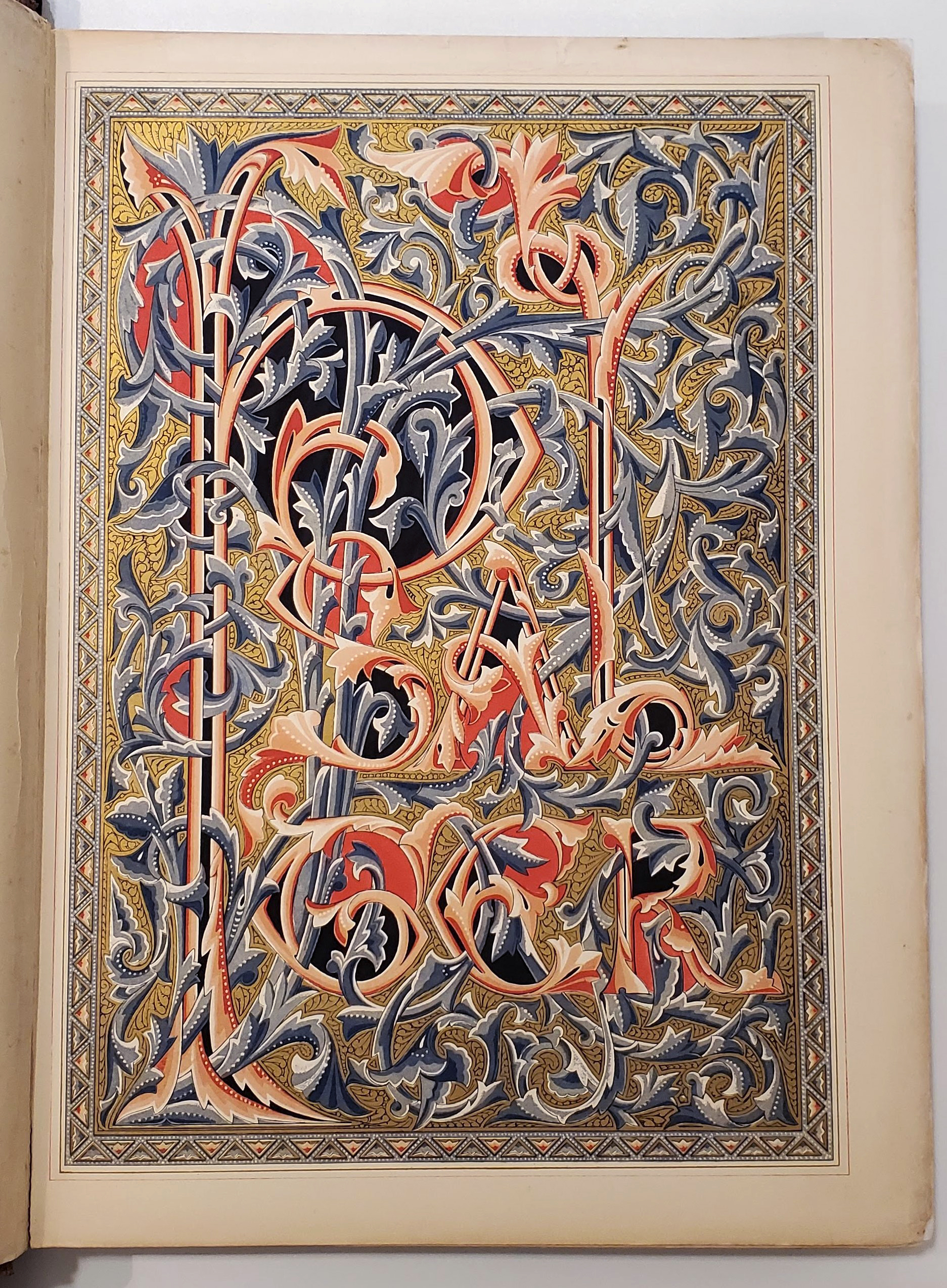 This book of the Psalms of David by architect and designer Owen Jones, also called the Victoria Psalter because its dedication to Queen Victoria was accepted, is one of the most ornate examples of Victorian bookbinding and chromolithography. With its design, illumination, and binding Jones wished to imitate medieval manuscripts and create a work with visual impact made for ornamentation rather than to be read. As mentioned, its pages were made through a process known as chromolithography.
This book of the Psalms of David by architect and designer Owen Jones, also called the Victoria Psalter because its dedication to Queen Victoria was accepted, is one of the most ornate examples of Victorian bookbinding and chromolithography. With its design, illumination, and binding Jones wished to imitate medieval manuscripts and create a work with visual impact made for ornamentation rather than to be read. As mentioned, its pages were made through a process known as chromolithography.
Chromolithography, and all lithography, is a planographic process, meaning the printing is done on a flat surface, rather than on a surface which has been cut into like engravings and woodcuts. The process is possible based on the principle that oil and water do not mix. First, the artist draws with an oil-based crayon or ink on a flat surface, typically limestone but it could also be a metal plate of zinc or aluminium. Once the drawing is complete the image must be etched into the stone. To do this powder and liquid layers are worked into the stone, beginning with powdered rosin, then powdered talc, and finally gum arabic/ a gum arabic solution. This creates a chemical reaction between the solution and the stone which fixes the drawing created with an oily substance while also making sure the blank areas are able to absorb water and repel any ink put on the stone. After this process the image is removed with a solvent and asphaltum is buffed into the surface. Despite the removal of the drawing a trace of the image is still visible, etched into the stone. Finally, the stone is ready to be inked for printing. The stone is dampened and the water is absorbed by the blank areas, then when the stone is inked the oil-based ink clings to the areas where the oil-based drawing was and is repelled by the water in the blank areas. Damp paper is then placed on the stone and it is put through a lithographic press. To achieve all the colours (gold, black, three shades of red and three shades of blue) on the pages of the Victoria Psalter, each page went through multiple printings like this, with a new stone required for each additional colour. Therefore, for a page with all the colours, eight stones would have been required. The paper must also be lined up correctly so that all of the colours have the proper registration, or alignment, on the page. While the pages inside are beautiful, perhaps even more striking is the binding which contains them.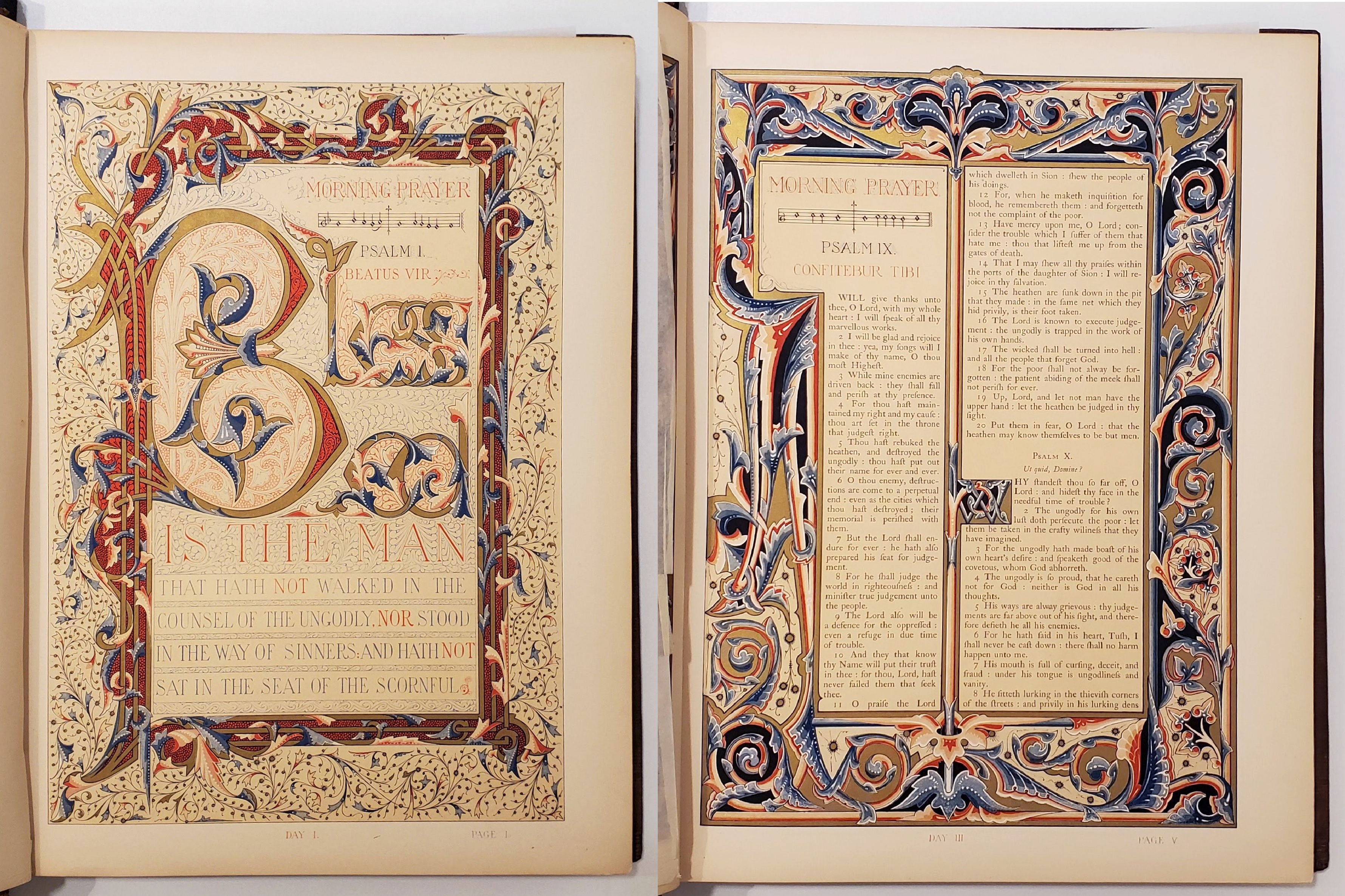
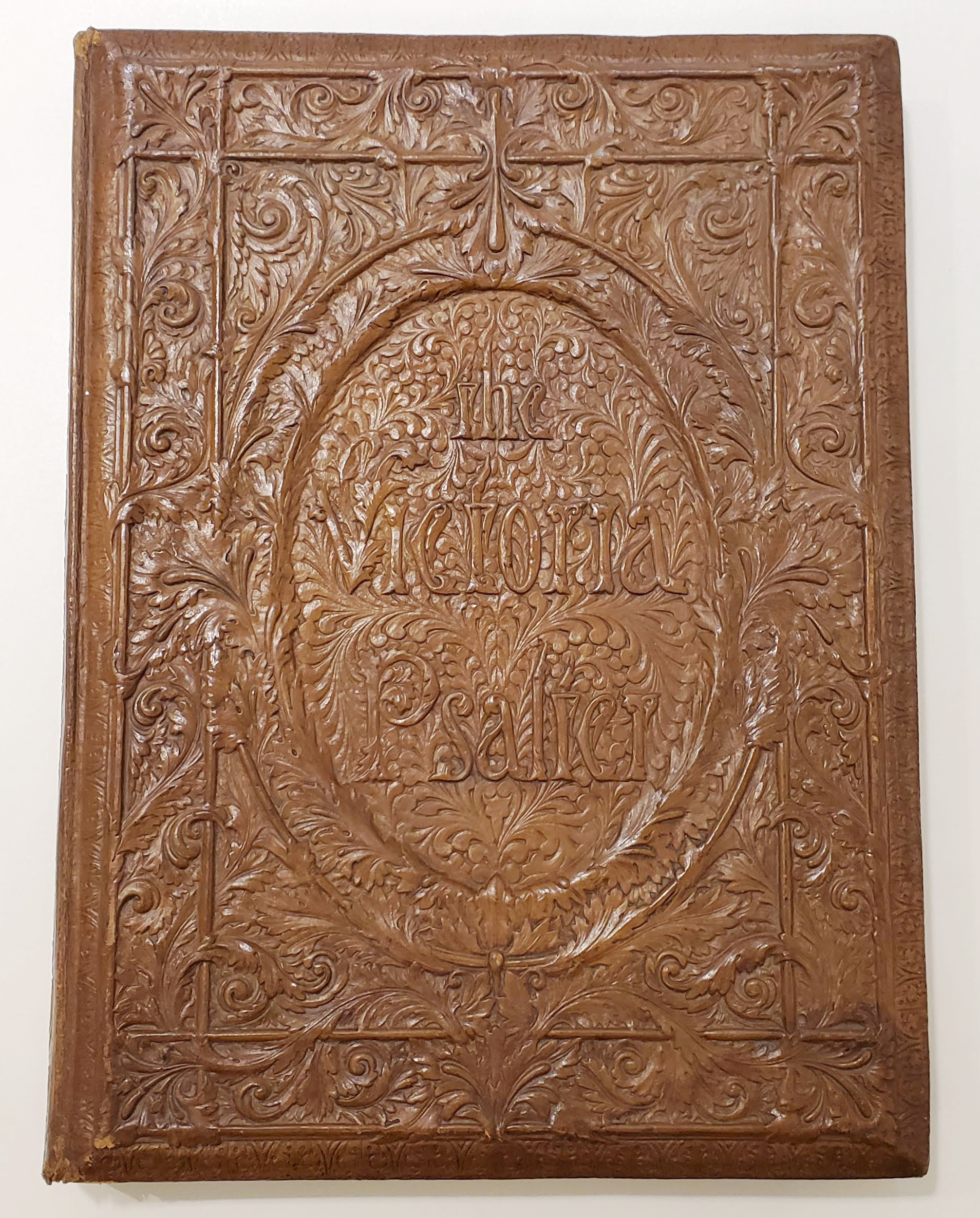 The Victoria Psalter has a deeply embossed calf binding known as a relievo binding. The process of creating a relievo binding was patented by Frederick Leake for leather hangings and was used in bindings from the 1840s to the 1860s. For this process a massive fly embossing press was built in the basement of Edmonds & Remnants. To emboss the leather the lower iron bed with metal dies on top is heated and a counter die made of glued together millboard is attached to the upper bed of the press. When the dies are ready, the embosser places the leather in the press then directs the man working the press to swing the arms of the press around until the millboard is brought down upon the metal die and the leather is embossed. This process needs to be done three times, for the spine and both covers. The Victoria Psalter was embossed by Edmonds & Remnants as they were the only firm in England known to have the enormous fly embossing press, but the book was bound by Leighton Son and Hodge. The end result is an elaborate almost three-dimensional looking binding that is considered one of Jones' masterpieces.
The Victoria Psalter has a deeply embossed calf binding known as a relievo binding. The process of creating a relievo binding was patented by Frederick Leake for leather hangings and was used in bindings from the 1840s to the 1860s. For this process a massive fly embossing press was built in the basement of Edmonds & Remnants. To emboss the leather the lower iron bed with metal dies on top is heated and a counter die made of glued together millboard is attached to the upper bed of the press. When the dies are ready, the embosser places the leather in the press then directs the man working the press to swing the arms of the press around until the millboard is brought down upon the metal die and the leather is embossed. This process needs to be done three times, for the spine and both covers. The Victoria Psalter was embossed by Edmonds & Remnants as they were the only firm in England known to have the enormous fly embossing press, but the book was bound by Leighton Son and Hodge. The end result is an elaborate almost three-dimensional looking binding that is considered one of Jones' masterpieces.
The Victoria Psalter was donated to the Clara Thomas Archives and Special Collections by Robert C. Brandeis.
Record: 18757 Oversize
Milton, John. Paradise Lost: a Poem, in Twelve Books. Edited by Thomas Newton. Birmingham: Printed by John Baskerville for J. and R. Tonson, in London, 1758.
Milton, John. Paradise Regain'd: a Poem, in Four Books: to Which is Added Samson Agonistes, and Poems Upon Several Occasions. Edited by Thomas Newton. Birmingham: Printed by John Baskerville for J. and R. Tonson, in London, 1758.
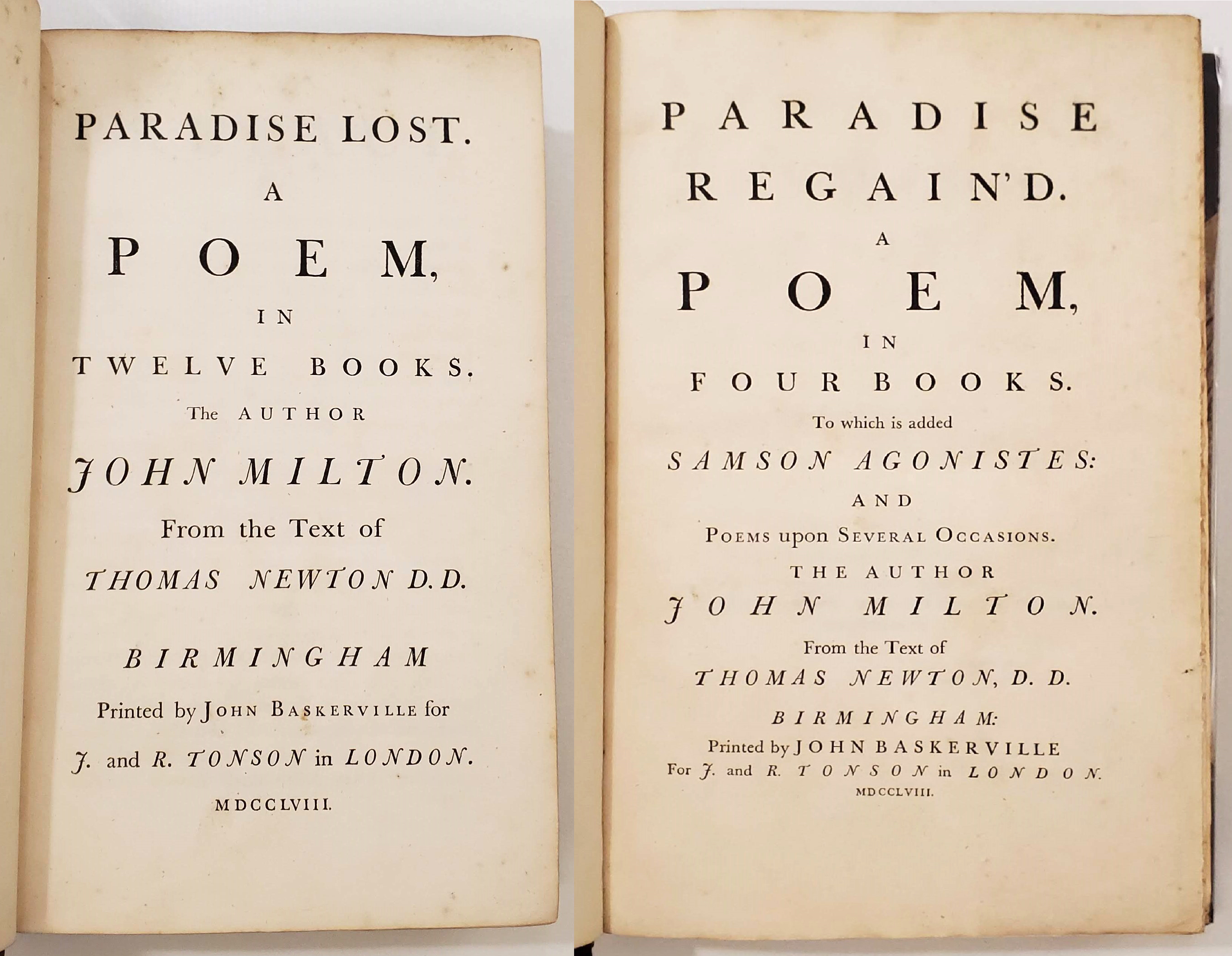 ASC has recently acquired two copies of Milton's Paradise Lost and Paradise Regain'd, both printed by John Baskerville in 1758. If the name Baskerville sounds familiar, it may be because he is regarded as one of the finest printers from the eighteenth century, or that his name is used on computer fonts to this day, based on his type or a later type cut based on his designs. Born in 1707, by his twenties John Baskerville was known as a writing-master (a teacher of calligraphy) and a gravestone letter-cutter working in Birmingham. Baskerville then began working on lacquering various household items, such as tea trays, in a process known as japanning. Unfortunately, none of his works have been identified, however it was this work that financed his entry into printing. Baskerville began experimenting with printing around 1750 but his first book, Virgil's Bucolica, Georgica, et Aeneis was not published until 1757. In the preface to Paradise Lost Baskerville explains that he wished to print "books of Consequence, of intrinsic merit, or established Reputation...in an elegant dress." However, at the time his books were not well received in England, thought of as nothing more than the work of an amateur, and some did not sell well. This thinking continued into the nineteenth century, though there were always others that espoused his genius, especially that his type was a mix of beauty and utility. By the twentieth century biographies of Baskerville were beginning to be written and a revival of his typeface was underway as he was recognized as a great typographer. Now, Baskerville is recognized not only for his achievements in typography, but also for his work in other aspects of printing, including his improvements to the printing press, refining inks, and helping to develop wove paper. In fact, Baskerville's 1757 printing of Virgil is thought to be the first printing on wove paper in Europe.
ASC has recently acquired two copies of Milton's Paradise Lost and Paradise Regain'd, both printed by John Baskerville in 1758. If the name Baskerville sounds familiar, it may be because he is regarded as one of the finest printers from the eighteenth century, or that his name is used on computer fonts to this day, based on his type or a later type cut based on his designs. Born in 1707, by his twenties John Baskerville was known as a writing-master (a teacher of calligraphy) and a gravestone letter-cutter working in Birmingham. Baskerville then began working on lacquering various household items, such as tea trays, in a process known as japanning. Unfortunately, none of his works have been identified, however it was this work that financed his entry into printing. Baskerville began experimenting with printing around 1750 but his first book, Virgil's Bucolica, Georgica, et Aeneis was not published until 1757. In the preface to Paradise Lost Baskerville explains that he wished to print "books of Consequence, of intrinsic merit, or established Reputation...in an elegant dress." However, at the time his books were not well received in England, thought of as nothing more than the work of an amateur, and some did not sell well. This thinking continued into the nineteenth century, though there were always others that espoused his genius, especially that his type was a mix of beauty and utility. By the twentieth century biographies of Baskerville were beginning to be written and a revival of his typeface was underway as he was recognized as a great typographer. Now, Baskerville is recognized not only for his achievements in typography, but also for his work in other aspects of printing, including his improvements to the printing press, refining inks, and helping to develop wove paper. In fact, Baskerville's 1757 printing of Virgil is thought to be the first printing on wove paper in Europe.
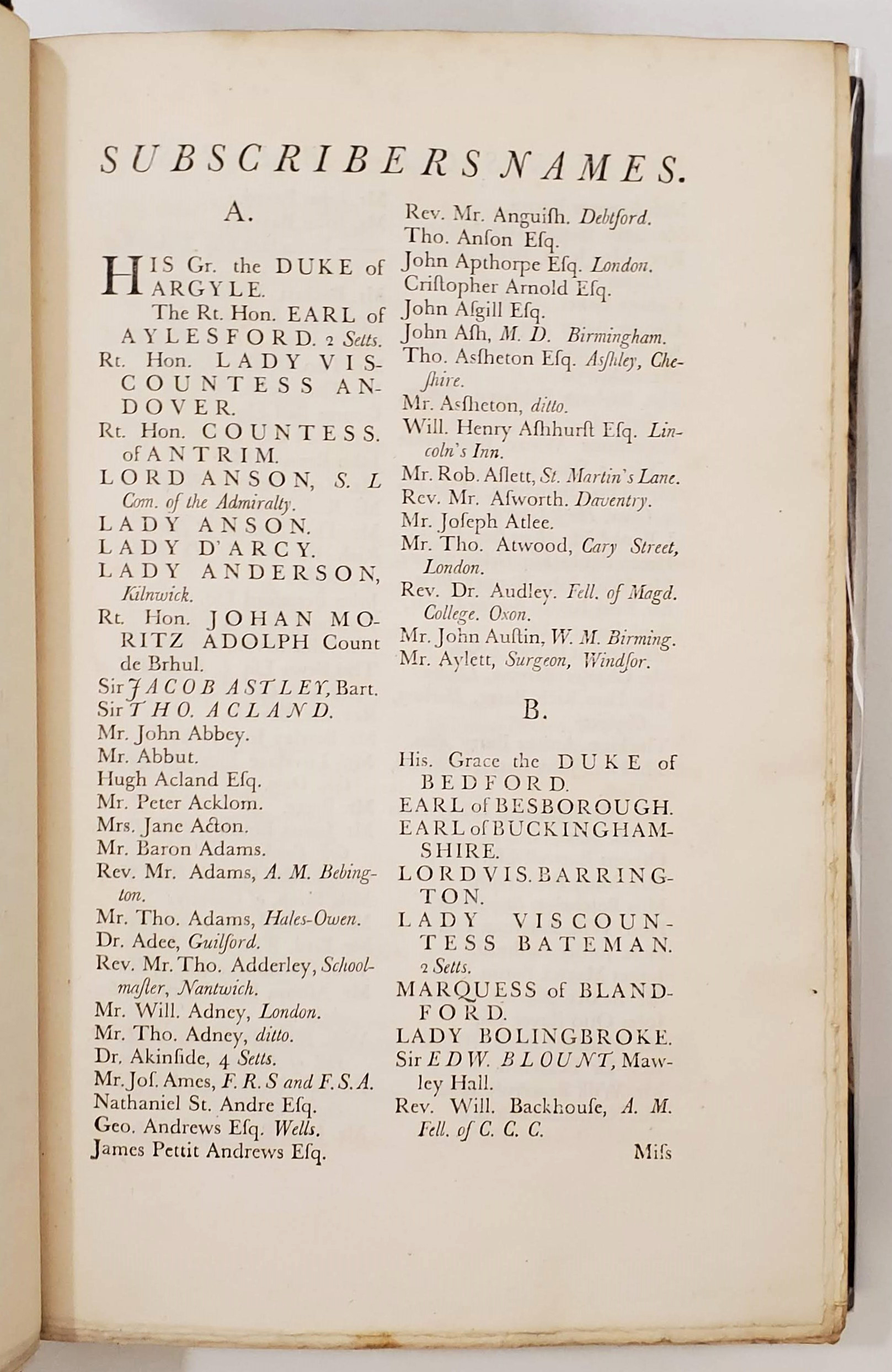 In addition to Baskerville's 1763 Cambridge bible (13569), considered his masterwork, and his later Birmingham Bible printed in 1769 (18761), ASC has two 1758 octavo copies of Milton's Paradise Lost and Paradise Regain'd, but the copies differ in significant ways. First, the outside. In previous blog posts we have discussed how during the Hand Press Period books were bound by their owners, not by the publisher or bookseller. Indeed, Baskerville generally sold his books unbound in sheets. This left the binding up to the purchaser. In this case the first copy is bound in half leather with a Gloster marbled paper and the second has a full calf binding with a gold tooled border. The customization of the bindings also meant that owners could customize the inside before it was bound. The most notable differences between the two copies are what was included (or omitted) and where. The list of subscribers' names (people who helped pay for the book's production) in Paradise Lost is omitted from the second copy. In addition, the section "The Life of Milton" that is typically found in Paradise Regain'd, as is the case with the first copy, it is missing from copy 2 and can instead be found in copy 2 of Paradise Lost. The omission of the subscribers' list is especially noteworthy because without the second copy, ASC would not have the complete work as printed by Baskerville. These customizations are noticeable but there are also subtle differences that indicates the two copies are different states.
In addition to Baskerville's 1763 Cambridge bible (13569), considered his masterwork, and his later Birmingham Bible printed in 1769 (18761), ASC has two 1758 octavo copies of Milton's Paradise Lost and Paradise Regain'd, but the copies differ in significant ways. First, the outside. In previous blog posts we have discussed how during the Hand Press Period books were bound by their owners, not by the publisher or bookseller. Indeed, Baskerville generally sold his books unbound in sheets. This left the binding up to the purchaser. In this case the first copy is bound in half leather with a Gloster marbled paper and the second has a full calf binding with a gold tooled border. The customization of the bindings also meant that owners could customize the inside before it was bound. The most notable differences between the two copies are what was included (or omitted) and where. The list of subscribers' names (people who helped pay for the book's production) in Paradise Lost is omitted from the second copy. In addition, the section "The Life of Milton" that is typically found in Paradise Regain'd, as is the case with the first copy, it is missing from copy 2 and can instead be found in copy 2 of Paradise Lost. The omission of the subscribers' list is especially noteworthy because without the second copy, ASC would not have the complete work as printed by Baskerville. These customizations are noticeable but there are also subtle differences that indicates the two copies are different states.
While state is a complicated term in bibliography that is continuously redefined, it can be understood as alterations, corrections, additions, or excisions of the text during manufacture that a printer or publisher does not want to bring attention to. 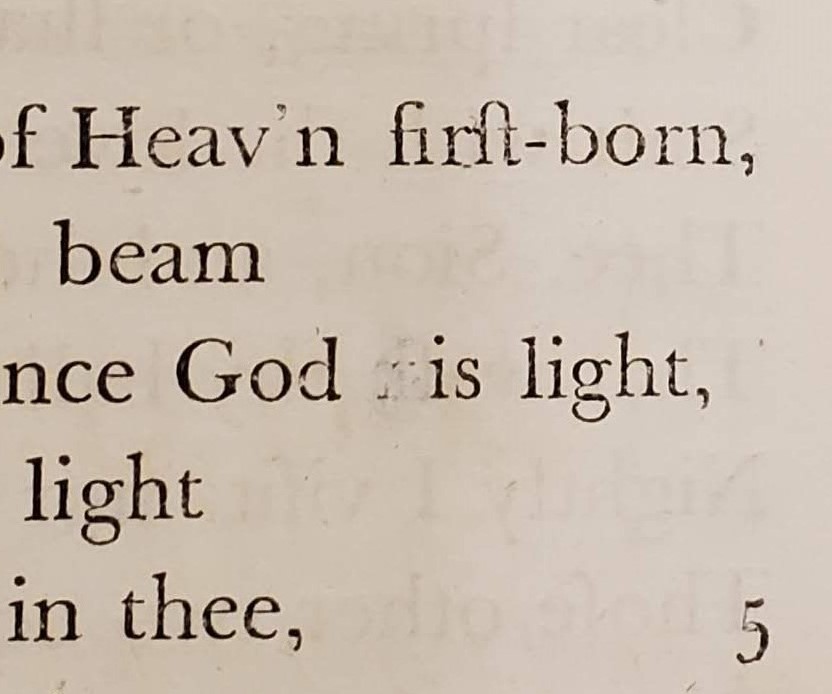 States are framed within the context of editions, books printed from a set-up of type without substantial changes, and impressions, the copies of an edition printed at one time. With books printed before the mid eighteenth century these terms are commonly interchangeable because a printer would not keep type set up after printing the desired number of copies, instead they would redistribute the moveable type back into the printer's tray to be used for other works. Therefore different states often occur when errors are noticed during printing and corrected for subsequent copies, but the originals, with the errors, are still often sold as printed. The result is variant states of a book, with minute alterations and errors that can distinguish copies from one another. This is also the case with ASC's two copies of Paradise Lost. There are various errors present in both copies such as the "h" of "God his light" on page 75 being erased by hand, but only in copy 2 is there the error of a roman "I" in the italic Paradise on page 346. These subtle differences are often found and catalogued by bibliographers which can then be used by researchers to compare against their copies at hand. Here, the errors were noted by Baskerville's bibliographer Philip Gaskell.
States are framed within the context of editions, books printed from a set-up of type without substantial changes, and impressions, the copies of an edition printed at one time. With books printed before the mid eighteenth century these terms are commonly interchangeable because a printer would not keep type set up after printing the desired number of copies, instead they would redistribute the moveable type back into the printer's tray to be used for other works. Therefore different states often occur when errors are noticed during printing and corrected for subsequent copies, but the originals, with the errors, are still often sold as printed. The result is variant states of a book, with minute alterations and errors that can distinguish copies from one another. This is also the case with ASC's two copies of Paradise Lost. There are various errors present in both copies such as the "h" of "God his light" on page 75 being erased by hand, but only in copy 2 is there the error of a roman "I" in the italic Paradise on page 346. These subtle differences are often found and catalogued by bibliographers which can then be used by researchers to compare against their copies at hand. Here, the errors were noted by Baskerville's bibliographer Philip Gaskell.
Paradise Lost Record: 18737
Paradise Regain'd Record: 18738
Written by Taylor Tryburski
References
https://victorianweb.org/art/design/books/cooke18.html
https://www.historyofinformation.com/detail.php?id=4630
McLean, Ruari. Victorian Book Design & Colour Printing. London: Faber & Faber, 1963.
Tomlinson, Charles. Cyclopedia of Useful Arts: Mechanical and Chemical, Manufactures, Mining, and Engineering. London: George Virtue, 1854.
Archer, Caroline, and Malcolm Dick. John Baskerville: Art and Industry of the Enlightenment. Liverpool: Liverpool University Press, 2017.
Carter, John, and Nicolas Barker. ABC for Book Collectors. 8th edition with corrections. New Castle, DE: Oak Knoll Press, 2013.
Gaskell, Philip. John Baskerville: a Bibliography. Cambridge: At the University Press, 1959.

